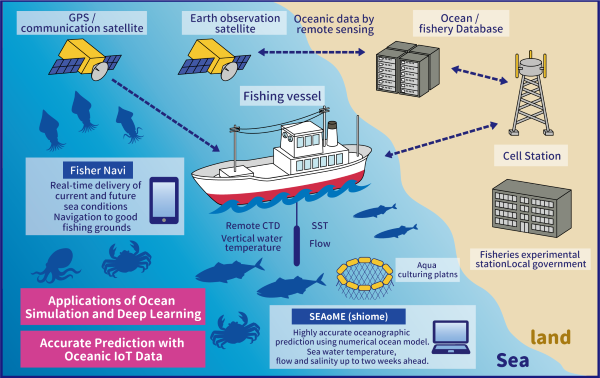Our Vision
OceanEyes aims to achieve “A society in which fishers can continue their fisheries in a stable manner in the future” and “A society in which the earth’s rich marine resources are sustainable” through its R&D and business activities. Sustainable fisheries is one of the United Nations SDGs and is recognized as a global issue.

With the revision of the Fisheries Law for the first time in 70 years and the introduction of controlled fishing in Japan as well, fishers are required to continue their business by making profits by reducing operating costs and increasing unit prices under the restricted catch. In order to improve the operation cost, it is effective to accurately determine the fishing ground and reduce the unnecessary fishing ground search cost. At present, however, fishers are forced to rely on data that is far from up-to-date and sufficiently accurate. The concept of operation based on data itself is not yet widespread enough. Furthermore, with the aging of fishermen, it is becoming difficult for veteran fishermen to pass on their skills, and the gap in skills between young and experienced fishermen is widening. OceanEyes aims to improve this situation by promoting innovation through “eye of the art” based on the latest technology.

OceanEyes has developed and offered as a service a technology for estimating the current and future conditions of oceanographic conditions, such as ocean temperature and the direction and strength of tidal currents, and a FishTech technology for predicting good fishing grounds based on such oceanographic condition predictions.
OceanEyes’ hydrographic prediction technology is a method in which a supercomputer calculates hydrographic conditions based on a numerical model of oceanophysics, and data assimilation technology that assimilates the numerical model and actual observation results enables highly accurate prediction. The system is capable of predicting ocean areas such as islands and inland seas with a resolution of 2 km mesh, which is more detailed than the 10 km resolution commonly used today. In the future, we are working to improve the model with the aim of predicting sea conditions in the hundreds of meters. We are also developing OnSpot sea condition prediction technology that can predict sea conditions near fishing vessels on demand in the hundreds to tens of meters by combining data measured by sensors mounted on fishing vessels. It is expected to be useful for actual fishing operations of fishing vessels such as netting.
We are also developing a technology to remove clouds from satellite observation data and restore seawater temperature data at a high speed by using deep-sea learning image restoration technology for satellite observation data, as a method to provide seawater temperature more frequently than simulation using a supercomputer, which takes time to calculate. It is now possible to provide seawater temperatures two hours earlier.
Furthermore, by combining the ocean temperature patterns observed by these satellites with the actual operation records with location information, we are learning the skills of veteran fishermen and developing a technique to estimate the fishing grounds where fish are most likely to be caught in the current sea conditions.
Ocean Eyes provides solutions to these social issues based on our previous development of FishTech, and aims to realize “Sustainable fisheries for fishers and the earth”.
RECCA: Origin of Ocean Eyes
The origin of Ocean Eyes is in “Research Program on Climate Change Adaptation (RECCA)” which began in 2010. At RECCA, JAMSTEC, Aomori Prefecture Industrial Technology Center, Fisheries Research Institute, Fisheries Research Agency, Kyoto Univ. and Hokkaido Univ. set up research teams. The team have developed technologies for estimating the variation of fishery ground and fisheries resources of aquatica due to global warming. We also have developed technology for providing necessary information of adapting measures. The results are currently being offered to fishermen in Aomori Prefecture.
At this time Ocean Eyes uses artificial intelligence, especially the technology of the deep learning, but at that time it was a machine forestry random forest and SVM prosperity, before the neural network became popular yet. In Ocean Eyes, research is continuing before the current third AI boom starts.
CREST : Sustainable Fishery × Artificial Intelligence (AI) Technology
Since 2016 after the end of the RECCA project, the proposal of sustainable fisheries, mainly JAMSTEC and Kyoto University, was adopted as one of the themes of the artificial intelligence domain of the CREST funding program of Japan Science and Technology Agency (JST).
In CREST, with the vision of the realization of sustainable fishery, we comprehensibly conserve resources and economics, analyze various kinds of big data on marine weather and fishery acquired in fishery activities by artificial intelligence technology, and develop technology for providing information to fishermen and municipalities. From the marine / fishery big data, we develop technologies for high-precision ocean weather forecasting and techniques to find good fishing grounds, and by providing the information obtained there to business users, administrators and marine industries.
CREST 「サステイナブル漁業に向けたデータ指向型リアルタイム解析基盤の開発」
The establishment of a Ocean Eyes Company
Ocean Eyes Co., Ltd. was established on April 1, 2019, with the aim of incorporating the results of 10 years of research and development into society. Basic research is carried out by Kyoto University and JAMSTEC, service implementation, sales and marketing is carried out by Ocean Eyes, and the company’s business philosophy is to realize sustainable fisheries and marine industries.
